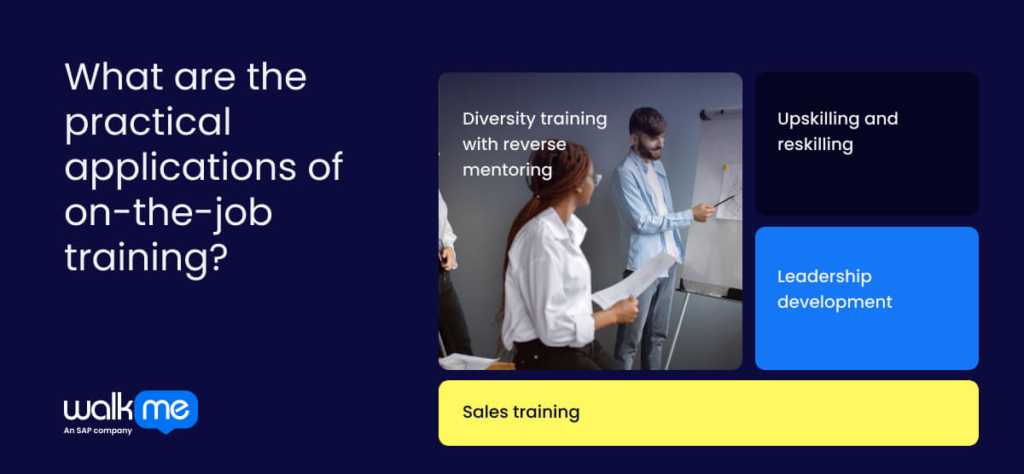When it comes to the different types of employee training, on-the-job training is one of the most widely used methods today. Many workplace tasks are straightforward enough that new hires can pick them up without formal instruction.
On-the-job training builds on this by providing direct, hands-on experience in real work environments. Employees strengthen knowledge, bridge talent shortages, and gain a deeper understanding of company processes.
Many organizations naturally incorporate on-the-job training. When well-structured, it is practical, adaptable, and aligned with evolving workplace needs.
This article explores how on-the-job training works, the best delivery methods, and when to apply it for maximum effectiveness.
What is on-the-job training?
On-the-job training develops employee skills through direct experience in the workplace. Learning happens while performing regular job duties, making it an immediate and practical method of gaining new competencies.
This type of training allows employees to apply knowledge in real work settings, reinforcing learning through direct practice. It strengthens employee morale, supports problem-solving skills, improves task proficiency, and deepens understanding of job functions. Employees retain information better because they learn within the context of their actual responsibilities.
Not all training tied to daily work is on the job. Flight simulators train pilots, and customer service agents practice role-plays in an office. These simulations occur at work but are separate from real tasks. On-the-job training happens while employees perform their actual duties.
What are the different types of on-the-job training?

On-the-job training happens naturally in workplaces with a strong learning culture. Experienced staff share knowledge, and junior staff are prepared to accept those lessons as part of their continuous learning and development.
However, many HR departments wisely invest time and effort in structured on-the-job training programs.
Let’s explore three major types of on-the-job training. These structured methods are easy to implement, track, and sustain in an enterprise.
Apprenticeships
Apprenticeships combine practical experience with formal education. Apprentices learn directly from experienced professionals, gaining hands-on skills immediately applicable to their chosen field.
This provides job-specific training, equipping individuals with the expertise to succeed. While often associated with technical fields, apprenticeships are now being applied in various industries. They help bridge the gap between theory and practice, enabling smoother transitions into professional roles.
Job rotation
Job rotation exposes employees to multiple roles within the organization. It can include job shadowing, cross-training, or leadership programs. This exposure broadens employees’ skill sets and deepens their understanding of the company’s operations.
Effective job rotation requires close collaboration between HR and management. It strengthens employees’ commitment to the organization as they gain insight into various functions and grow their capabilities. Job rotation also helps identify high-potential employees, preparing them for future leadership positions.
Peer mentoring
Peer mentoring pairs experienced employees with colleagues to share role-specific knowledge. It encourages informal learning and knowledge sharing and promotes a collaborative workplace culture.
Peer mentors provide practical insights and guide others through challenges in real-time. This type of mentoring helps employees develop their skills quickly and strengthens team relationships. Unlike formal training programs, peer mentoring is flexible and adapts to individual learning styles.
What are the practical applications of on-the-job training?

On-the-job training can enhance employee experiences across organizations, from technical training to the different areas of organizational change. It is an intrinsic part of training for doctors, nurses, and teachers and is vital for people management at every level of the organizational hierarchy.
This section introduces practical applications for on-the-job training and showcases how they can enhance the workplace.
Diversity training with reverse mentoring
Diversity training is essential at all organizational levels. Reverse mentoring takes it a step further by pairing junior staff with senior leaders to share unique insights on diversity.
A recent BBC report highlighted how reverse mentoring helped UK leaders understand LGBTQ+ issues and social mobility challenges. This approach fosters cultural change, improves retention, and promotes skill sharing, including digital skills.
How to Implement:
- Carefully pair mentors and mentees based on their experience, communication style, and mutual learning goals.
- Integrate reverse mentoring into broader diversity strategies to support company values and inclusivity.
- Allocate dedicated time for mentoring sessions, ensuring participants can focus without distractions or pressure from other duties.
- Schedule regular check-ins to assess progress, address challenges, and adjust as needed to ensure an impactful experience.
Upskilling and reskilling
Upskilling and reskilling are directly tied to closing talent gaps, especially when employees can apply what they have learned during their regular tasks.
On-the-job training is effective because it allows employees to quickly integrate new skills while staying relevant to evolving industry standards.
As employees take on new challenges in their roles, they learn on the go and adapt to the specific demands of their jobs. Specialized training ensures that skills are directly applicable, helping employees progress in their current positions while preparing them for future needs.
How to implement:
- Carefully match on-the-job training with short-term projects and long-term leadership development to address immediate and future needs.
- Blend on-the-job training with off-the-job learning (e.g., classroom sessions) to create a balanced approach that facilitates a deeper understanding of concepts.
- Allocate sufficient resources and time for trainers to ensure active participation and hands-on guidance, reinforcing the application of learned skills in the workplace.
- Routinely assess training progress, adjusting as needed to ensure relevance and growth.
Leadership development
Developing leadership through on-the-job training requires more than exposure—it demands immersion in real challenges. Rotating through roles forces aspiring leaders to adapt and balance immediate demands with long-term strategy.
Shadowing senior staff offers an unfiltered view of high-level decision-making, from resolving conflicts to managing complex projects. Cross-training sharpens problem-solving, requiring quick thinking in unfamiliar situations.
Each experience builds confidence and resilience, shaping leaders who can anticipate challenges, make decisive choices, and navigate shifting priorities with clarity and control.
How to Implement
- Structure job rotations, shadowing, or cross-training around leadership competencies like strategic thinking, crisis management, and cross-functional collaboration.
- Use detailed feedback tools like performance scorecards or structured coaching reports to measure leadership growth and address skill gaps.
- Pair participants with experienced mentors who provide targeted guidance, helping them navigate complex decisions and high-stakes responsibilities.
- Gradually introduce leaders to larger projects, budgeting responsibilities, or team oversight to strengthen problem-solving and executive decision-making.
Sales training
Sales training builds expertise through direct exposure to real sales environments. Trainees observe seasoned professionals, breaking down negotiation tactics, objection handling, and client engagement strategies. Live sales interactions reinforce adaptability, teaching them to adjust pitches based on customer responses.
Shadowing sessions provide insight into deal structuring, pricing discussions, and competitive positioning. By handling real prospects under supervision, trainees sharpen persuasion skills and learn to navigate high-stakes conversations.
This hands-on strategy strengthens confidence, accelerates learning, and refines closing techniques.
How to implement:
- Start with controlled sales exercises like scripted calls and mock pitches before moving to live client interactions.
- Include trainees in senior sales meetings to analyze objections, contract negotiations, and competitive positioning.
- Rotate trainees across lead generation, account management, and closing roles to build a full sales cycle understanding.
- Assign supervised sales targets, tracking progress with real-time feedback on pitch effectiveness, objection handling, and deal conversion.
- Pair trainees with top-performing sales reps for shadowing sessions that break down closing techniques and persuasion tactics.
Get future-ready with on-the-job-training
On-the-job training can address the skill gap demand by immersing employees directly in their roles. This allows them to learn as they go, making the knowledge immediately applicable.
As industries face ongoing skill shortages, this method proves effective for rapidly developing essential capabilities. Employees gain practical experience while adapting to evolving technologies and constantly changing business needs. The immediate relevance of the training ensures that skills remain aligned with these needs.
This method builds stronger employee loyalty by offering clear pathways for advancement. When used alongside other development strategies, it supports long-term growth and strengthens a business’s ability to meet shifting externalities.
FAQs
For remote or hybrid teams, on-the-job training can be done using virtual tools like video calls and collaborative platforms. Assignments and projects can be tracked through shared workspaces. Regular check-ins and feedback ensure that learning is practical and aligned with job tasks, even without in-person supervision.
On-the-job training helps new employees quickly understand their roles. It provides hands-on experience with tasks, systems, and team culture, allowing them to learn as they go. Real-time exposure speeds up integration, ensuring they become more productive and confident in their duties.
On-the-job training keeps employees engaged by showing how learning affects their work. It builds confidence and skill, leading to higher job satisfaction. Employees feel more involved in their roles, motivating them to perform well and stay committed to their responsibilities.

